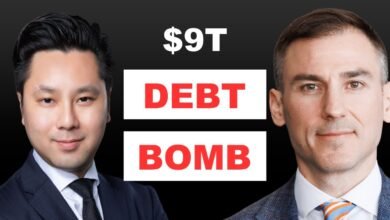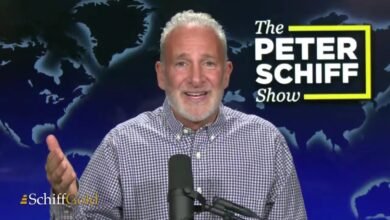People Have NO IDEA What’s Coming In 2025 (Uncut) 01-28-2025
“People Have NO IDEA What’s Coming In 2025…”: Rick Rule | Gold and Silver Price 2025
The decade of the 1970s and late 1960s was in many senses unpleasant. People on fixed incomes, people who relied on their social security, found themselves getting social security, but they found that their check every month bought less than it bought the month before. When savers took control of the interest rate market, people found that the interest rate paid on their first mortgages went from 5.5% to 17.5% or 18%.
Pretty unpleasant. And people who owned long bonds got killed. Somebody who owned a really riskless instrument, which is to say a 30-year U.S. Treasury, where their income was guaranteed for 30 years, found that the capitalized value of their 30-year bond in the decade 1970 to 1980 declined by 70%.
So holders of long-term debt got massacred. People on fixed incomes got massacred. Salary earners, where their skillset didn’t enable them to price their labor relative to the price of capital, that is to say, employees that didn’t have skillsets that allowed them to raise their rates, also in terms of their purchasing power, got massacred.
One consequence of that was massive social division in the United States. I’m not saying that we’re going to see a return to domestic violence, but I’m not saying that we aren’t either. When people are resentful and they’re looking for a cause of their resentment, they very seldom look in the mirror.
They most commonly look elsewhere. My hope is this. My hope is that my caution around debt and deficits is wrong.
Hope is that the requirement for working people that they have contestable skills, I hope that’s wrong. My hope is I’m wrong about the gold price. A $9,000 or $10,000 gold price implies a lot of things about the way other assets in society perform.
It implies a real change in one’s lifestyle, and my lifestyle is great. I would really, really, really like it if I was able to say, God, I got that one wrong. We got through it fine.
The debt didn’t matter. The deficits didn’t matter. Contestability didn’t matter.
I just don’t think that’s the case. I’m almost 72 years of age. Medicare, Medicaid, Social Security, my generation voted ourselves all kinds of cool benefits.
We took the money, we spent it, and we’re leaving you all a bill. These entitlements really are an intergenerational transfer of stolen property. My generation doesn’t want to think of themselves as thieves.
They want to think about the fact that they paid into these programs over the years. They neglect to understand that with Social Security as an example, all the money that was paid in was invested in federal IOUs, and that money was spent funding current deficits. When somebody says I paid in, I need to say to them, yes, you did.
You did, in fact, and that money was misappropriated. It’s gone. The fact that you think you deserve it is interesting, but it’s not relevant.
That’s going to cause some resentment. The economic scenario of the late 1960s and 1970s offers a sobering lesson in financial mismanagement and its dire consequences on individuals in the broader economy. Fixed income earners reliant on Social Security found their monthly checks shrinking in real terms, unable to keep pace with inflation.
This wasn’t just a theoretical concern. The purchasing power of their benefits eroded month by month. The cost of living soared, and what once seemed like a manageable expense became an insurmountable challenge.
The ripple effects extended beyond individuals, wreaking havoc on financial markets and society at large. One stark example was the soaring interest rates on mortgages. During this period, rates leaped from 5 to 6 percent to an eye-watering 17.5 to 18 percent.
The repercussions for homeowners and aspiring buyers were devastating. Monthly payments ballooned, forcing many out of the housing market and crushing the dreams of homeownership. Meanwhile, holders of long-term bonds faced a grim reality.
What had once been considered riskless assets, 30-year U.S. Treasuries suffered a catastrophic 70% decline in value. Investors who sought safety in these instruments found themselves bearing the brunt of inflation’s relentless assault. The social fabric of the United States also bore the brunt of this economic turmoil.
As resentment brewed among those struggling to make ends meet, societal tensions escalated. A divided populace began searching for scapegoats, often failing to recognize the systemic issues at play. This division sowed discord, creating fertile ground for unrest.
While the specifics of societal discord today may differ, parallels to those turbulent times are impossible to ignore. Now let’s turn to the modern implications. The debt and deficit issues plaguing today’s economy bear a striking resemblance to those of the 1970s, albeit on a much larger scale.
Rick Rule aptly highlights how our generation has not only repeated past mistakes but has also amplified them. Programs like Medicare, Medicaid, and Social Security, while crucial, have become unsustainable due to decades of financial mismanagement. These entitlements, as Rule bluntly puts it, represent an intergenerational transfer of stolen property.
While many Americans believe they’ve earned these benefits through contributions, the reality is that those funds were spent long ago, leaving future generations to foot the bill. The math behind this dilemma is grim. Social Security, for example, was initially designed to provide subsistence-level benefits to retirees aged 65 and older, at a time when the average life expectancy was just 66 years.
Today, life expectancy has increased to approximately 80 years, and individuals can begin receiving benefits as early as 62. This demographic shift has placed an unsustainable burden on the system, a fact that policymakers can no longer ignore. The question is, how will they address it? Rule predicts a series of incremental changes to the system.
For instance, the cap on income subject to Social Security taxation is likely to be lifted, ensuring high earners contribute more. However, this will be accompanied by means testing, effectively barring wealthy retirees from collecting benefits. Additionally, the eligibility age for Social Security will inevitably rise, reflecting longer life expectancies and a greater need for fiscal sustainability.
While these measures may mitigate the problem temporarily, they won’t address the root issue, the sheer scale of the unfunded liabilities. This brings us to the more insidious solution, inflation. As Rule explains, the government will likely honor its obligations nominally, continuing to pay retirees their promised benefits.
However, these payments will lose their purchasing power over time due to inflation. In other words, retirees will receive the same dollar amount, but those dollars will buy significantly less. This strategy mirrors the approach taken in the 1970s, when inflation eroded the real value of entitlements.
Moreover, the Consumer Price Index, CPI, the metric used to calculate cost of living adjustments, systematically understates inflation. This ensures that benefits fail to keep pace with rising costs, allowing the government to effectively reduce its liabilities without making overt cuts. The consequences of this approach are profound.
For retirees, the erosion of purchasing power can mean the difference between a comfortable retirement and financial hardship. For younger generations, it represents a betrayal of trust as they inherit a system that is fundamentally broken. And for society at large, it risks exacerbating inequality and social unrest, much like it did in the 1970s.
First of all, I believe that they’re going to tinker around the edges. I believe that the politicians will have no choice but to say to an old rich guy like me, the cap is going to come off your social security contribution. That is, the fact that you don’t get taxed for social security now on income above $160,000, that’s going to go away.
We’re going to tax you on all of it. And then we’re going to means test social security, which means despite the fact that the cap came off, you ain’t going to get it. Yes, we said it was an insurance program, and we lied.
It’s not an insurance program. It’s a transfer program. The second thing they’re going to do, and that’s okay.
There’s very few rich people. You know, it’s easy for a whole bunch of people to screw a few people. That works.
The second thing that they’re going to do, and they have to do it, is they’re going to have to change the age that people begin to receive their social security. When social security was enacted, it provided basically poverty-level, subsistence-level benefits to people 65 years of age and older. The average life expectancy of an American male in those years was 66 years.
So it covered you for a year. That’s changed now. The average life expectancy of the median American male is about 80 years, up from 65.
And you can begin to receive benefits at 62, unless you’re disabled, in which case you can receive it earlier. You follow what I’m saying? Oh, yes. Yes, I am.
They’re going to have to change that, and people are really, really, really going to be angry about that. The final thing, though, because that doesn’t matter, changing it around the edges. It really doesn’t matter.
Like these geniuses, Bernie and AOC and all these people have said, no problem. No problem. Tax the billionaires.
Well, it gets back to math again. The problem is $100 trillion, and the IRS estimate of the aggregate net worth of American billionaires is $5.6 trillion. So never mind raising their tax.
If you stole all their money, if you stole all their money, you’d solve 5% of the problem. It would not matter. So the way they’ll get around it is that they’ll honor their nominal obligations to most old guys.
Whatever they pay me now, $4,000 a month, something like that, I don’t even know. They’ll still pay me that. What’ll happen, I think, is that if you’re supposed to get $4,000, you’ll continue to get $4,000, but the $4,000 will buy you $1,000 worth of stuff after 10.
They will not index your tax to inflation, and they’ll inflate away the value of your benefit. That’s precisely what they did in the decade of the 1970s. That’s one of the reasons why the CPI understates the rate of inflation, because the CPI is the benefits escalator on entitlements.
It is in their interest to understate inflation. The profound narrative surrounding gold and silver as stalwart guardians against economic instability grows increasingly relevant in today’s global financial ecosystem. As central banks amass unprecedented reserves and nations reassess their reliance on fiat currencies, the implications for investors are seismic.
Let’s dive deeper into these dynamics and explore why tangible assets like gold and silver are commanding renewed attention. Gold’s enduring role as a hedge against economic turbulence cannot be overstated. In times of uncertainty, gold has historically served as a sanctuary for wealth preservation.
Central banks across the globe are intensifying their efforts to accumulate gold reserves, with recent data showcasing record-breaking acquisitions. This trend is not merely symbolic. It is an unequivocal acknowledgement of gold’s unparalleled value in a world grappling with mounting debt and fluctuating currencies.
China, for example, has been discreetly bolstering its gold reserves. While official reports indicate modest acquisitions, investigative analysis reveals a significantly larger volume. By circumventing traditional reporting mechanisms and directly sourcing gold from miners and intermediaries, China demonstrates strategic foresight in securing its economic sovereignty.
Similarly, Saudi Arabia’s recent surge in gold imports underscores a broader shift among nations seeking to insulate themselves from the vulnerabilities of a dollar-centric global economy. For individual investors, the lesson is clear. When central banks double down on gold, it signals a critical recalibration of priorities.
Gold is not just a relic of the past. It is a cornerstone for the future, offering security amid an increasingly unpredictable financial landscape. Silver, often overshadowed by its golden counterpart, is undergoing a renaissance.
As industries pivot toward greener technologies, silver’s dual role as a precious metal and an industrial necessity is driving unprecedented demand. From solar panels to electric vehicles, silver is indispensable in facilitating the transition to sustainable energy. This burgeoning demand, coupled with diminishing mining outputs, positions silver as a compelling investment opportunity.
In recent years, the silver market has experienced supply deficits with consumption outpacing production. Unlike gold, a significant portion of silver is consumed in industrial processes, leaving less for investment purposes. As stockpiles dwindle, the scarcity of silver is poised to amplify its value.
Investors who recognize silver’s dual appeal stand to benefit significantly, particularly as industries intensify their reliance on this versatile metal. Geopolitical tensions further amplify the allure of gold and silver. As the global power dynamic shifts, nations are increasingly wary of economic sanctions and the weaponization of currencies.
This apprehension has catalyzed a movement toward de-dollarization, with countries exploring alternative settlement mechanisms and currencies backed by tangible assets like gold. The BRICS coalition — Brazil, Russia, India, China, and South Africa — exemplifies this shift. By advocating for a gold-backed trade settlement currency, the BRICS nations are challenging the dominance of the U.S. dollar in international trade.
Although the proposal has yet to materialize fully, its implications are profound. A successful transition to a gold-backed currency would redefine the global economic order, potentially diminishing the dollar’s hegemony and elevating the importance of gold in international finance. Investors should view these developments as a wake-up call.
The diversification of global reserves away from fiat currencies underscores the inherent risks of an over-reliance on paper assets. Gold and silver, with their intrinsic value, offer a hedge against these geopolitical uncertainties, providing a buffer against the volatility of fiat-based economies. Inflation, often referred to as the silent thief, continues to erode purchasing power at an alarming rate.
While official inflation metrics may understate the true impact, the lived experience of rising costs tells a different story. From escalating housing prices to surging energy costs, inflation is reshaping the financial landscape. Gold and silver emerge as antidotes to this erosion.
Unlike fiat currencies, which are subject to devaluation through monetary policy, gold and silver retain their value over time. They are not mere commodities. They are monetary anchors, preserving wealth in the face of inflationary pressures.
For investors, incorporating gold and silver into their portfolios is not just a defensive strategy. It is a proactive measure to safeguard financial well-being. Investing in gold and silver is not merely a financial decision.
It is a psychological one. These metals represent stability and permanence in an era defined by transience and volatility. Their allure transcends market cycles, resonating with investors who seek refuge from the unpredictability of traditional assets.
However, it is essential to approach precious metals investing with a long-term perspective. Unlike speculative assets that promise quick returns, gold and silver thrive on patience and resilience. They are not instruments for immediate gratification, but rather vehicles for enduring security.
This mindset shift is crucial for investors looking to navigate the complexities of today’s economic landscape. Central banks, as the stewards of national economies, offer invaluable insights into the strategic importance of gold. Their aggressive accumulation of gold reserves is a testament to its enduring relevance.
By observing the actions of central banks, individual investors can glean critical lessons in risk management and asset allocation. The message is clear. If central banks are prioritizing gold as a hedge against economic uncertainty, individual investors should follow suit.
Gold’s universal appeal and intrinsic value make it an indispensable component of any diversified portfolio. It is not merely an investment. It is a safeguard against the vulnerabilities of a fiat-driven financial system.
As we look to the future, the case for gold and silver becomes increasingly compelling. These metals are not relics of the past. They are instruments of resilience, offering stability in a world of change.
Their value transcends market fluctuations, grounded in their intrinsic worth and universal appeal. For investors, the path forward is clear. Embrace the timeless wisdom of gold and silver.
Recognize their potential not just as commodities, but as pillars of financial security. In a world defined by uncertainty, they stand as beacons of stability, guiding investors toward a future of prosperity and peace of mind. Gold and silver are more than assets.
They are symbols of resilience and stability. Their enduring value, rooted in their intrinsic worth, offers a counterbalance to the volatility of modern markets. As central banks continue to accumulate these metals and nations explore alternatives to fiat currencies, the significance of gold and silver is undeniable.
For investors, the time to act is now. The dynamics of the global economy are shifting. And those who recognize the importance of gold and silver will be well positioned to navigate these changes.
Embrace the golden shield and silver lining. They are not just investments, they are legacies, preserving wealth for generations to come. Stay informed about the latest developments shaping the precious metals market with regular updates from the Finance Daily team.
Not only that, but as a subscriber you’ll also receive timely silver and gold price notifications and early access to groundbreaking news unavailable to the general public. Join our free gold and silver newsletter today. Link in the description.




